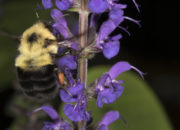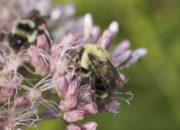An early season, widespread species. Males appear as early as June and are gone by September.
Identification: Straightforward with a clear view of the upper thorax. T2 always with some yellow in the middle, which can range from a very distinct square to a few hairs along the edge closest to the head. The thorax has perhaps the most distinct black dot of any Vermont bumble bee. Males are quite variable, with some looking similar to females and others having expensive yellow on T3 – T5.
Similar Species:
Common Eastern Bumble Bee (Bombus impatiens): The thorax has shorter hair, with a grayish smudge in place of the distinct black dot on Two-spotted. Common Eastern rarely has any yellow on T2.
Brown-belted Bumble Bee (Bombus griseocollis): Also has a patch of yellow/brown in the middle of T2 and some workers can be pretty similar. In Brown-belted the patch on T2 is often a dirty yellow, approaching brown and concave vs. the bright yellow square on Two-spotted. Additionally Brown-belted has short, even hair appearing like a buzz cut with a very clean transition from yellow to black behind the head. Two-spotted usually has a small triangle of yellow hairs on the top of the head between the eyes.
Red-belted Bumble Bee (Bombus rufocinctus): Can be similar to Two-spotted drones, though male Red-belted have larger eyes.
Global Status: Secure (G5)
Vermont Status: Not Ranked
For more information, visit the following links:
Discover Life
Living Atlas Species Page
Distribution:
To see the global distribution, check out the iNaturalist account, and toggle the GBIF layer on the map.








